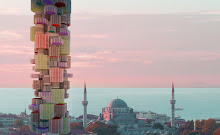 Indulge me a quick minute down memory lane. I was nine years old, sitting in French class in Tokyo, just a handful of days before winter break. Since it was so close to the holidays, my french teacher suspended our usual lessons of verb conjugation and reading in favor of story-telling. Since she was always especially animated, stories told by her would always capture our interest and imagination. That day, she told us about this special island off the coast of Brittany and Normandy called Mont Saint Michel.
Indulge me a quick minute down memory lane. I was nine years old, sitting in French class in Tokyo, just a handful of days before winter break. Since it was so close to the holidays, my french teacher suspended our usual lessons of verb conjugation and reading in favor of story-telling. Since she was always especially animated, stories told by her would always capture our interest and imagination. That day, she told us about this special island off the coast of Brittany and Normandy called Mont Saint Michel.
 To be perfectly honest, I don't remember much of what she said that day. It has been a while. But what I do remember are her descriptions of what seemed to me to be a magical island in the middle of the sea which had a special bridge - sometimes you could walk to the island and other times the sea would hide the bridge, like it was never there. For years, I carried that image in my head. My childhood imagination and wonderment became adult curiosity and a mission. Over the years, I have tried several times to visit this island, even traveling to the edges of Normandy, but somehow my planning never worked out and it remained an elusive destination. And so this 'mountain island' remained a figment of my imagination - until now. Twenty-seven years later, I finally made my trip to the top of Mont Saint Michel.
To be perfectly honest, I don't remember much of what she said that day. It has been a while. But what I do remember are her descriptions of what seemed to me to be a magical island in the middle of the sea which had a special bridge - sometimes you could walk to the island and other times the sea would hide the bridge, like it was never there. For years, I carried that image in my head. My childhood imagination and wonderment became adult curiosity and a mission. Over the years, I have tried several times to visit this island, even traveling to the edges of Normandy, but somehow my planning never worked out and it remained an elusive destination. And so this 'mountain island' remained a figment of my imagination - until now. Twenty-seven years later, I finally made my trip to the top of Mont Saint Michel.
 The origins of Mont-Saint-Michel are thought to date back to 708, when a sanctuary was built for the archangel by Aubert, Bishop of Avranches, who claimed he was inspired to do so when St. Michael came to him in a dream. Soon after the mount became a major destination for pilgrims. In the 10th century, the Benedictines settled in the Abbey, while a village grew below its walls. During the 100 years war with Britain, Mont-Saint-Michel became a military stronghold, successfully repelling English assaults and thus became a symbol of national identity for the French.
The origins of Mont-Saint-Michel are thought to date back to 708, when a sanctuary was built for the archangel by Aubert, Bishop of Avranches, who claimed he was inspired to do so when St. Michael came to him in a dream. Soon after the mount became a major destination for pilgrims. In the 10th century, the Benedictines settled in the Abbey, while a village grew below its walls. During the 100 years war with Britain, Mont-Saint-Michel became a military stronghold, successfully repelling English assaults and thus became a symbol of national identity for the French.
 A statue of St. Michael slaying the dragon
A statue of St. Michael slaying the dragon
From the start of the French revolution, up until 1863, the abbey was used as a prison, imprisoning clerics who opposed the republican regime. However, by the mid 1830's, influential members of French society, like Victor Hugo, started a push to have Mont-St.-Michel designated a national treasure, which it was in 1874. In 1979, UNESCO designated it a World Heritage Site.
 Facade of abbey church
Facade of abbey churchThe abbey church that was started in 1000, is a blend of Romanesque and Gothic architecture. The unique proportions of the church are based on the area available on the top of the rock.
 The Cloister built at the beginning of the 13th century was a place for meditation and prayer
The Cloister built at the beginning of the 13th century was a place for meditation and prayer
and served as a connector between various buildings.
 Detail of cloister spandrels
Detail of cloister spandrels

The town while extremely charming and well preserved since its medieval origins, loses some of its mystique and charm with the swarming tourists and kitschy souvenir shops. While these stores may have existed in the Middle Ages, selling pilgrims mementos from their religious journey, I doubt they consisted of cheesy plastic replicas of the abbey, most likely made in China.
 Store signs at the base of Mont St. Michel
Store signs at the base of Mont St. Michel
My experiences on the island were truly memorable. The buildings were incredibly well preserved. This jewel of an environment really transported you to another time and now that I am back home, I am more in awe of what I saw when I look at my pictures. However, the one thing I kept looking for, even as the bus drove us back to the train station at dusk, were the rushing even violent tides that envelope the base of the fortified island. They were a critical part of the Mont St-Michel I read about over the years and was told 27 years ago in French class.
 Village buildings
Village buildingsWhat I learned after my visit was that in 1879, the bridge that I wrote about in the beginning was converted into a causeway. Then in 1969, the River Couesnon around Mont St-Michel was canalized, reducing the flow of water and increasing the build up of silt around the island. However, in 2006, the French government authorized the building of a dam to reintroduce the tides and river currents around Mont St. Michel by flushing the surrounding silt and salt marshes back to the sea. This should once again transform this mount to the island it once was. This project will be completed by 2012 and the image I carried with me for 27 years will be restored.
 The base of Mont St-Michel at low tide
The base of Mont St-Michel at low tide



 Facade of abbey church
Facade of abbey church The Cloister built at the beginning of the 13th century was a place for meditation and prayer
The Cloister built at the beginning of the 13th century was a place for meditation and prayer The town while extremely charming and well preserved since its medieval origins, loses some of its mystique and charm with the swarming tourists and kitschy souvenir shops. While these stores may have existed in the Middle Ages, selling pilgrims mementos from their religious journey, I doubt they consisted of cheesy plastic replicas of the abbey, most likely made in China.
The town while extremely charming and well preserved since its medieval origins, loses some of its mystique and charm with the swarming tourists and kitschy souvenir shops. While these stores may have existed in the Middle Ages, selling pilgrims mementos from their religious journey, I doubt they consisted of cheesy plastic replicas of the abbey, most likely made in China. My experiences on the island were truly memorable. The buildings were incredibly well preserved. This jewel of an environment really transported you to another time and now that I am back home, I am more in awe of what I saw when I look at my pictures. However, the one thing I kept looking for, even as the bus drove us back to the train station at dusk, were the rushing even violent tides that envelope the base of the fortified island. They were a critical part of the Mont St-Michel I read about over the years and was told 27 years ago in French class.
My experiences on the island were truly memorable. The buildings were incredibly well preserved. This jewel of an environment really transported you to another time and now that I am back home, I am more in awe of what I saw when I look at my pictures. However, the one thing I kept looking for, even as the bus drove us back to the train station at dusk, were the rushing even violent tides that envelope the base of the fortified island. They were a critical part of the Mont St-Michel I read about over the years and was told 27 years ago in French class. Village buildings
Village buildings
































No comments:
Post a Comment